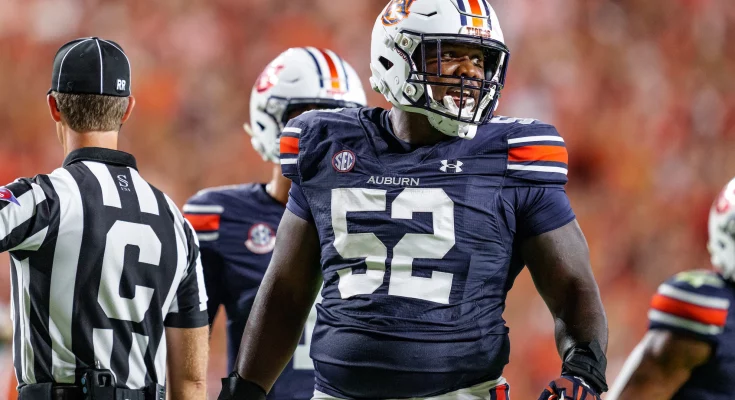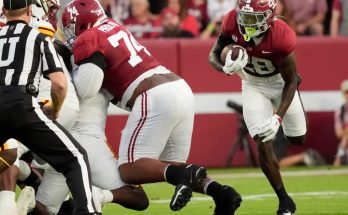The landscape of college football is ever-evolving, a dynamic tapestry woven with transfer portal decisions, coaching changes, and the relentless pursuit of on-field excellence. For the Auburn Tigers, a significant thread in this intricate design over the past couple of seasons has been the presence of Dillon Wade on their offensive line. Fans of the orange and blue have grown accustomed to seeing the imposing figure of No. 52, a stalwart whose consistent performance has often been a silver lining in what has at times been a fluctuating offensive identity. Yet, the intriguing question that has consistently surrounded Wade is not if he will be on the field, but rather where on the offensive line he will line up. This perpetual positional fluidity, while a testament to Wade’s remarkable versatility, also offers a fascinating lens through which to examine the intricacies of offensive line play, player development, and the strategic machinations of college football coaching.
To truly appreciate Dillon Wade’s journey and his invaluable role within the Auburn program, one must first understand the demanding nature of offensive line play. Often referred to as the “unseen heroes” of football, offensive linemen operate in a realm of highly specialized techniques and immense physical strain. Their primary objective is twofold: protect the quarterback from relentless pass rushers and create running lanes for ball carriers. This seemingly simple description belies the profound complexity of their responsibilities. Each position on the offensive line – left tackle, left guard, center, right guard, and right tackle – demands a unique skill set and a distinct physical profile.
The tackles, positioned on the ends of the line, are typically the longest and most agile linemen. Their role is to protect the quarterback’s blind side (for the left tackle) and the strong side (for the right tackle) from edge rushers, often the most athletic and explosive defenders. This requires exceptional footwork, quick reaction time, and the ability to mirror agile opponents in open space. A false step, a slow hand punch, or a momentary lapse in concentration can result in a devastating sack or a disrupted play, often leading to a turnover or a loss of yardage. The left tackle, in particular, is frequently considered the premier position on the offensive line, as they are tasked with protecting the quarterback’s most vulnerable side, especially for right-handed signal-callers.
Moving inward, the guards are responsible for protecting the interior of the pocket and creating push in the run game. They need to be powerful, stout, and adept at combination blocks with the tackles and the center. Their battles are often fought in tighter quarters, requiring explosive power, excellent leverage, and the ability to absorb and redirect powerful bull rushes. They are frequently involved in pulling assignments, where they vacate their initial position to lead block for a running back on an outside run, demanding surprising athleticism for their size.
Finally, the center is the intellectual hub of the offensive line. Beyond snapping the ball to the quarterback, the center is responsible for making line calls, identifying defensive fronts, and communicating blocking assignments to the rest of the unit. This requires not only physical prowess but also exceptional football IQ, strong leadership skills, and the ability to think quickly under pressure. The center often faces direct engagement with defensive tackles, requiring a blend of strength and agility to anchor against powerful rushes.
Dillon Wade’s collegiate career began at Tulsa, where he predominantly played left tackle. This foundational experience at a critical position instilled in him the technical nuances and competitive grit required to succeed at the highest levels of the sport. His performance at Tulsa was impressive enough to make him a highly sought-after commodity in the transfer portal, ultimately landing him at Auburn in 2023. His arrival was met with anticipation, as the Tigers sought to bolster an offensive line that had experienced its share of struggles.
Upon his transfer to Auburn, Wade quickly settled into the starting left tackle role, a testament to his talent and ability to adapt to a new system and higher level of competition. For a player to seamlessly transition from one program to another and immediately secure such a vital starting position speaks volumes about his work ethic and innate understanding of offensive line play. In his first season on the Plains, he anchored the left side, taking the majority of snaps at left tackle and demonstrating a strong ability in pass protection. Pro Football Focus, a prominent analytical site, even graded him as Auburn’s best pass-blocker among their main offensive line rotation that season.
However, the 2024 season brought new dynamics to the Auburn offensive line. The arrival of transfer tackles like Percy Lewis from Mississippi State and Tyler Johnson, among others, offered Auburn’s offensive line coach, Jake Thornton, more flexibility in his personnel groupings. This influx of talent allowed for a strategic shift, as the coaching staff envisioned Wade moving inside to left guard. The rationale behind this move was multifaceted. While Wade had proven himself a capable left tackle, his physical dimensions and skill set were seen by many, including Coach Thornton, as a more natural fit for the guard position. Guards often benefit from a more compact build and explosive power, which aligns well with Wade’s attributes. The move was also seen as beneficial for Wade’s long-term NFL aspirations, as showcasing versatility and excelling at a position considered a better fit for his professional profile could significantly enhance his draft stock. As Wade himself noted, playing multiple positions makes a player “more valuable” to NFL teams, which typically only carry a limited number of offensive linemen on their 53-man rosters.
This planned transition to left guard for the 2024 season was initially successful, with Wade embracing the new role and excelling in early practices. He spoke about the difference in play, noting that at guard, he gets to “put my hand in the ground now so I’m coming off the ground with more power,” and that it felt “a lot less limitless as I’m going up against more guys my height.” This insight reveals a deeper understanding of the positional demands and how his body type and play style could be optimized. The transition, while initially challenging, was something he welcomed, understanding its long-term benefits.
However, the fluid nature of football depth charts and the unpredictable demands of a season soon tested Wade’s adaptability once more. Injuries, inconsistent play from other linemen, or unforeseen struggles at certain positions often necessitate adjustments. When Auburn faced early issues at left tackle during the 2024 season, neither Percy Lewis nor Tyler Johnson were able to consistently hold down the starting spot. In a clear demonstration of his “whatever the team needs” mentality, Dillon Wade was once again called upon to shift. He moved back out to left tackle, starting six games there, while also starting five games at left guard and even seeing some action at right tackle. This incredible flexibility meant he played over 100 snaps at three different positions, a remarkable feat of adaptability that few linemen possess.
This constant shuffling highlights a crucial aspect of offensive line coaching: finding the right combination of five players that work cohesively as a unit. It’s not simply about putting the five most talented individuals on the field; it’s about synergy, communication, and understanding each other’s tendencies. When one piece moves, the entire puzzle can be affected. Wade’s willingness and ability to move between guard and tackle provided Coach Thornton with invaluable flexibility, allowing him to address weaknesses and optimize the line’s overall performance.
As we look ahead to the 2025 season, the narrative surrounding Dillon Wade’s position on the Auburn offensive line continues to evolve, but with a clearer direction. With new transfer tackles like Xavier Chaplin and Mason Murphy joining the roster, the aim is for Wade to finally solidify his spot inside at left guard. This move, as Coach Thornton has emphasized, is what they “aimed to do last year” and “keeps him at his natural position, the position that he needs to play to give himself the best shot at the NFL.” The intention is to leverage his power and leverage in the interior, allowing him to truly flourish in the run game while maintaining his strong pass-blocking capabilities.
The significance of this projected stability for Wade cannot be overstated, both for his individual development and for the overall performance of the Auburn offense. Consistency in a single position allows an offensive lineman to refine their technique, build stronger chemistry with their adjacent teammates, and develop a deeper understanding of defensive schemes from that specific vantage point. While versatility is a valuable trait, being able to master one position can elevate a player’s game to an elite level.
Beyond his positional versatility, Dillon Wade is also embracing a crucial leadership role within the Auburn offensive line. As a veteran, he recognizes the importance of setting an example for younger players and fostering a culture of excellence. He’s spoken about “teaching everyone the rule of greatness,” emphasizing “maximum effort and doing the best you can every single day.” This kind of leadership is invaluable, particularly for an offensive line unit that relies so heavily on cohesion, trust, and shared commitment. A strong, unified offensive line can elevate an entire offense, providing the foundation for successful run plays and clean pockets for the quarterback.
The overall outlook for Auburn’s offensive line in 2025, with Wade anchoring the left guard spot, appears promising. With three projected starters from the previous season returning (Wade, center Connor Lew, and guard Jeremiah Wright) and the addition of impactful transfers, the unit is expected to be a major strength for the Tigers. Pro Football Focus even ranked Auburn’s offensive line among the top 10 nationally, a testament to the talent and potential within the group. A dominant offensive line is a quarterback’s best friend and a running back’s open door. For Auburn’s offense to take the next step and for their new transfer quarterback, Jackson Arnold, to thrive, the offensive line will be paramount.
In conclusion, Dillon Wade’s journey at Auburn is a compelling narrative of adaptability, resilience, and the relentless pursuit of improvement. From starting at left tackle to showcasing incredible versatility by playing multiple positions when the team needed him most, he has proven to be an indispensable asset. As he settles into his projected role at left guard for the 2025 season, the hope is that this newfound positional clarity will unlock his full potential, solidify the Auburn offensive line as a dominant force, and pave the way for a successful final collegiate season before he sets his sights on the NFL. For Auburn fans, the question of where No. 52 will line up might finally have a definitive answer, and it’s an answer that promises to bring strength, stability, and leadership to the heart of the Tigers’ offense. His story is a powerful reminder that in the demanding world of football, true value often lies not just in talent, but in the willingness to adapt, to sacrifice, and to embrace whatever role the team needs you to play.



